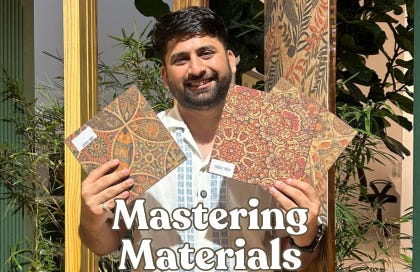Monday Muse Edition #7
Hello Musies,
Me, after staring at 100+ materials, still clueless about which one to pick.
You walk into a material showroom.
Marble, quartz, MDF, HPL, ACP, ceramic, veneer - so many options. You pick up a sample, flip it around, and confidently say:
"Yeah… this feels premium."
But most people think selecting materials is about aesthetics. They are Wrong.
The real challenge? Functionality, longevity, and what happens AFTER installation.
Ever seen a glossy tile that turns into an ice rink when wet?
Or a wooden floor that swells like a sponge during monsoons?
What about that facade material that started peeling within a year?
Bad material choices are expensive mistakes. Let’s make sure you don’t make them.
🚨 Why material selection often fails
Before we talk solutions, let’s bust the biggest material selection mistakes:
❌ Chasing trends blindly
Just because a material is trending doesn’t mean it works for your project.
🔥 Example: Cork flooring looks amazing in photos, but in a high-traffic commercial space? Nightmare to maintain.
❌ Ignoring lifecycle costs
Many materials seem cost-effective until the maintenance bills start stacking up.
🔥 Example: A cheap laminate kitchen counter that starts swelling near the sink in just 6 months.
❌ Forgetting user experience
A material might look good—but how does it feel?
🔥 Example: Ultra-glossy surfaces in high-touch areas = fingerprint magnets.
❌ Over-reliance on vendor samples
That 10x10 cm sample won’t show real-world wear & tear over time.
🔥 Example: A fabric sample looked durable - until it started fading and piling within months of use.
📌 The material selection blueprint: A smarter approach
1. The ‘material vs. context’ rule (avoid costly mistakes)
Materials aren’t universal. Their success depends on context.
Before picking any material, ask:
🔹 Where is it being used? (Interior, exterior, high-moisture area?)
🔹 Who is using it? (Kids, elderly, high foot traffic?)
🔹 What’s the climate? (Humidity, temperature changes, pollution levels?)
🔥 Example: A high-gloss white floor in a home with pets? Expect scratches within weeks.
💡 Takeaway: Materials should match use case + environment - not just aesthetics.
2. Why ‘maintenance-free’ materials are a myth
There’s no such thing as maintenance-free. There’s only low-maintenance vs. high-maintenance.
✅ Porcelain tiles: Stain-resistant, easy to clean
✅ Powder-coated aluminum: No rust, good for outdoor applications.
✅ Compact laminates: High scratch resistance, perfect for workspaces.
❌ Glossy finishes: Fingerprint magnets, difficult to maintain in high-touch areas.
❌ Natural marble in kitchens: Absorbs stains quickly (unless sealed regularly).
🔥 Example: A client wanted a "maintenance-free" bathroom. Reality? Every material requires some upkeep.
💡 Takeaway: When clients ask for “zero maintenance,” educate them—it doesn’t exist.
3. The durability vs. budget dilemma (what clients need to understand)
Most people assume higher cost = better material. That’s not always true.
🔹 Engineered wood gives a premium look at half the cost of solid wood.
🔹 UPVC doors offer durability similar to wood but need zero polishing.
🔹 High-pressure laminates (HPL) mimic real wood and stone but cost way less.
When should you spend more?
➡️ Wet areas (Bathrooms, balconies): Water resistance is non-negotiable.
➡️ High-impact zones (Entryways, staircases): Needs high durability.
➡️ Facades & Exteriors: UV, rain, and pollution protection are crucial.
💡 Takeaway: The right material balances durability and budget, not just cost.
4. The sustainability trap: what’s actually green?
Not every "eco-friendly" material is truly sustainable. Look beyond marketing buzzwords.
❌ Greenwashing: Many brands label products as “eco-friendly” without real backing.
✅ Check certifications: LEED, FSC (wood), EPD (Environmental Product Declaration).
✅ Local sourcing > Imported materials (Cuts transport emissions).
✅ Recyclability: Can this material be repurposed later?
Example:
💡 Bamboo sounds sustainable but often comes from chemically treated, non-ethical sources. Instead, opt for locally sourced reclaimed wood.
💡 Takeaway: Not all “green” materials are truly sustainable—always dig deeper.
📂 The Ultimate Material Pricing Framework
Ever been confused about how much materials actually cost?
We’re building the Material Pricing Framework 📊—a crowdsourced database tracking ₹/sqft price ranges for materials in architecture & interior design.
Why this matters:
✅ Avoid overpaying – Get a realistic price range.
✅ Make smarter choices – Know which materials fit your budget.
✅ Industry-driven & updated – Professionals like you help keep it accurate.
💾 Have pricing insights? Contribute here
Share this with fellow architects, contractors, or designers who can help!
🎥 Bonus: Future Materials of 2025 – What’s Next?
Materials are evolving faster than ever. Here’s what’s coming:
🔹 Self-healing concrete?
🔹 Carbon-negative bricks?
🔹 Hempcrete?
I covered some of the most exciting upcoming materials in my latest YouTube video:
🎬 Watch Here
Final takeaway: Materials can make or break a project
Next time you're selecting materials, ask yourself:
✔ Will this material last at least 10+ years without issues?
✔ Does it fit the climate, user needs, and long-term budget?
✔ Have I seen a real-life project using it after years of wear & tear?
Mastering materials = fewer regrets + better-performing designs.
📢 What’s the worst material mistake you’ve seen? Reply and let me know!
Would you share this?
This newsletter isn’t just another guide on material selection. It’s designed to be a go-to reference for architects, interior designers, and clients alike.
📌 If you found this useful, share it with one friend who struggles with material choices.
Let’s make smarter, regret-free material decisions! 🚀
Keep musing,
Ar.Sagar Saoji
Founder - f.y.i.arch
Architect turned Content Creator
Find me here: Instagram | Linkedin | Website
Listen to our Architecture Podcast
Ps. If you liked reading this newsletter, considering sharing it to a friend.
You can read our previous edition here.





